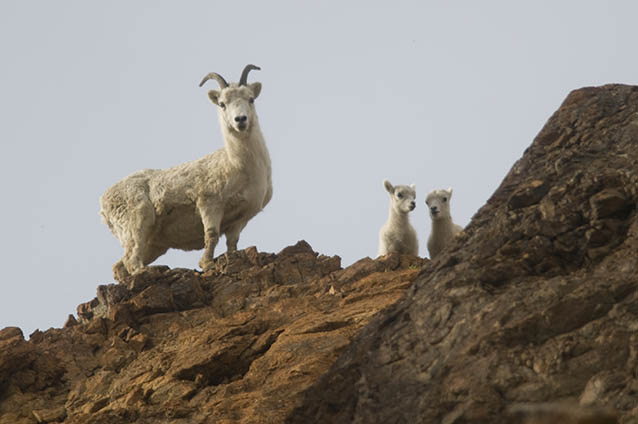Media Included
- Dall's Sheep Behaviors - Learn about common Dall's sheep behaviors.
Dall sheep employ a sophisticated social structure.
Social Structure

NPS Photo / Kent Miller
Dall sheep have a sophisticated social system. Females, called ewes, group together with lambs and yearlings, and males (or rams) herd together away from ewes and lambs, except during the rut, or mating season, which takes place in early winter. Rams establish social order and dominance over other males through a series of behaviors, including head on collisions with each other. These interactions intensify as the rut approaches. Ewes typically give birth to one lamb in the spring. Lambs can walk within 24 hours of birth. Twins are rare, but ewes often form nursery groups, and one ewe will watch over several lambs while other ewes forage or rest.
In Depth
Division of Gender Groups
Rams and ewes are rarely found in the same groups outside of the mating season, or rut, which occurs from mid-November through mid-December. For most of the year, rams feed in the best foraging areas to enhance their reproductive fitness. During spring and summer, ewes are more likely to select areas such as steep, rocky slopes with lower predation risk to raise offspring.
Social Behavior
Social order and dominance rank is maintained in ram groups through a variety of behaviors including head-on collisions. These dramatic clashes involve each ram getting a running start before colliding, horns-first into one another. Other behaviors associated with establishing social order include leg kicks, bluff charges, and dominance mounting. Most of this behavior establishes order year-round, but clashes between males intensify as the rut approaches. Ewes occasionally engage in similar competitive behavior over feeding or bedding sites. Young sheep practice such interactions as part of their play.
Seasonal Ranges
Rams are known to occupy up to six seasonal ranges, including different areas used during autumn, rut (or mating season from mid-November to mid-December), midwinter, late winter/spring, and summer, as well as spending time at salt licks.
For most of the year, ewes select areas free of snow and close to forage. After lambs are born, close proximity to escape terrain as well as nearby forage are important in habitat selection. Ewes and lambs will travel farther from escape terrain to forage when in larger groups.
Sources
- Bowyer, R. T., and D. M. Leslie Jr. 1992. Ovis dalli. Mammalian Species 393:1-7.
- Corti, P., and D. M. Shackleton. 2002. Relationship between predation-risk factors and sexual segregation of Dall’s sheep (Ovis dalli dalli). Canadian Journal of Zoology: 80:2108-2117.
- Nichols, L. and F. L. Bunnell. 1999. Natural history of thinhorn sheep. Pages 23-77 in R. Valdez and P.R. Krausman, editors. Mountain sheep of North America. The University of Arizona Press, Tucson, Arizona.
- Rachlow, J. L., and R. T. Bowyer. 1998. Habitat selection by Dall’s sheep (Ovis dalli): maternal trade-offs. Journal of Zoology 245:457-465.
Part of a series of articles titled Dall Sheep in Alaska's National Parks.
Previous: Dall Sheep
Last updated: June 26, 2023
